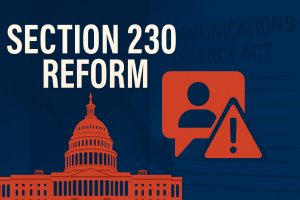Section 230 Reform: Charting the Future of Free Speech and Platform Accountability

The digital landscape of the 21st century rests on a relatively obscure yet powerful provision of U.S. law: Section 230 of the Communications Decency Act. Enacted in 1996, this law has been called “the 26 words that created the internet” — and for good reason. By shielding online platforms from liability for user-generated content while allowing them to moderate in good faith, Section 230 created the legal framework that enabled the rise of social media, user forums, and digital marketplaces. But today, this once-uncontroversial statute finds itself at the center of a political and legal firestorm.
What Is Section 230?
Section 230(c)(1) states that no provider or user of an interactive computer service shall be treated as the publisher or speaker of information provided by another content provider. This means platforms like Facebook, YouTube, Reddit, or even your local news site’s comment section can host third-party content without being legally responsible for it.
Section 230(c)(2) goes further, offering so-called “Good Samaritan” protection to platforms that voluntarily moderate content they find objectionable—even if that content is constitutionally protected speech—as long as the moderation is done in good faith.
These twin provisions created a legal safe harbor that allowed the internet to flourish. But nearly three decades later, critics across the political spectrum are questioning whether this immunity still serves the public interest.
Why the Debate Now?
From concerns about rampant misinformation during election cycles to the growing influence of algorithmic amplification, Section 230 is under more scrutiny than ever. Both conservatives and liberals agree that the current regime has flaws—but they sharply disagree on what the problems are and how to fix them.
-
Conservative voices often argue that tech companies engage in biased censorship, deplatforming certain viewpoints under the guise of moderation.
-
Progressive critics focus on the failure of platforms to adequately remove hate speech, harassment, and content harmful to children.
At the heart of these debates lies a single question: Should platforms bear greater legal responsibility for what happens on their services?
Proposals for Reform
Reforming Section 230 is no longer a fringe issue. It’s a mainstream legislative priority with bipartisan attention. Here are the major reform trajectories emerging in Washington and beyond:
1. Limiting Immunity for Content Removal
Some lawmakers propose restricting Section 230 protection when platforms remove lawful user content. This effort seeks to curb what critics call “censorship,” but it risks discouraging platforms from moderating harmful material altogether. Ironically, this could result in a digital environment even more hostile to civil discourse.
2. Federal Agency Involvement
Three federal agencies—the DOJ, FTC, and FCC—are jockeying to take the lead on Section 230 reform. While the DOJ has held forums on “Big Tech Censorship,” the FTC has invited public input on moderation practices, and the FCC has explored rulemaking authority. This patchwork of interest could lead to regulatory fragmentation unless Congress clearly delegates enforcement.
3. Sunset Legislation
Some proposals call for allowing Section 230 to expire entirely by the end of 2025. This would force lawmakers to craft a replacement framework. Critics warn, however, that a sunset approach could usher in legal chaos, with platforms drowning in lawsuits and users facing a severely fragmented internet.
4. Targeted and Nuanced Reforms
Groups like Public Knowledge and Article 19 advocate for more surgical changes. Rather than dismantling the entire statute, these reforms would focus on clarifying legal ambiguities, addressing specific harms (such as platform-enabled harassment), and maintaining protections for free speech and innovation.
5. Litigation and Judicial Challenges
Increasingly, courts are being asked to weigh in on the scope of Section 230. Recent legal strategies focus less on whether platforms “published” harmful content and more on how they designed and deployed recommendation algorithms that may have amplified that content. These arguments push the boundaries of existing doctrine and could redefine how courts interpret the statute.
Implications for the Internet Ecosystem
Reforming—or repealing—Section 230 carries profound consequences. A few likely outcomes include:
-
More Content Censorship: If platforms are liable for user posts, they may adopt overly cautious moderation practices to avoid lawsuits. That could suppress speech, especially from marginalized voices or controversial perspectives.
-
Less Content Moderation: Conversely, platforms might scale back moderation altogether to avoid being blamed for selective enforcement—resulting in more hate speech, misinformation, and abuse.
-
Innovation Chilling Effect: Smaller platforms and startups could be hit hardest. Without the legal shield of Section 230, they may lack the resources to manage legal risks, leaving the market dominated by entrenched tech giants.
-
Uncertain Enforcement Landscape: Without clarity on which agency governs Section 230 compliance—and under what standards—the regulatory regime may become incoherent and inconsistent.
Conclusion
Section 230 reform is no longer a hypothetical debate—it’s a live issue with the potential to reshape the internet as we know it. Lawmakers must walk a tightrope between protecting users from online harms and preserving the free, open digital ecosystem that Section 230 helped create. Whether through targeted legislation, agency rulemaking, or judicial interpretation, the coming years will be pivotal in determining who controls the digital public square—and under what rules.
As pressure mounts, one thing is clear: the conversation about Section 230 is not just about tech companies. It’s about the kind of internet we want to have—and who gets to decide.